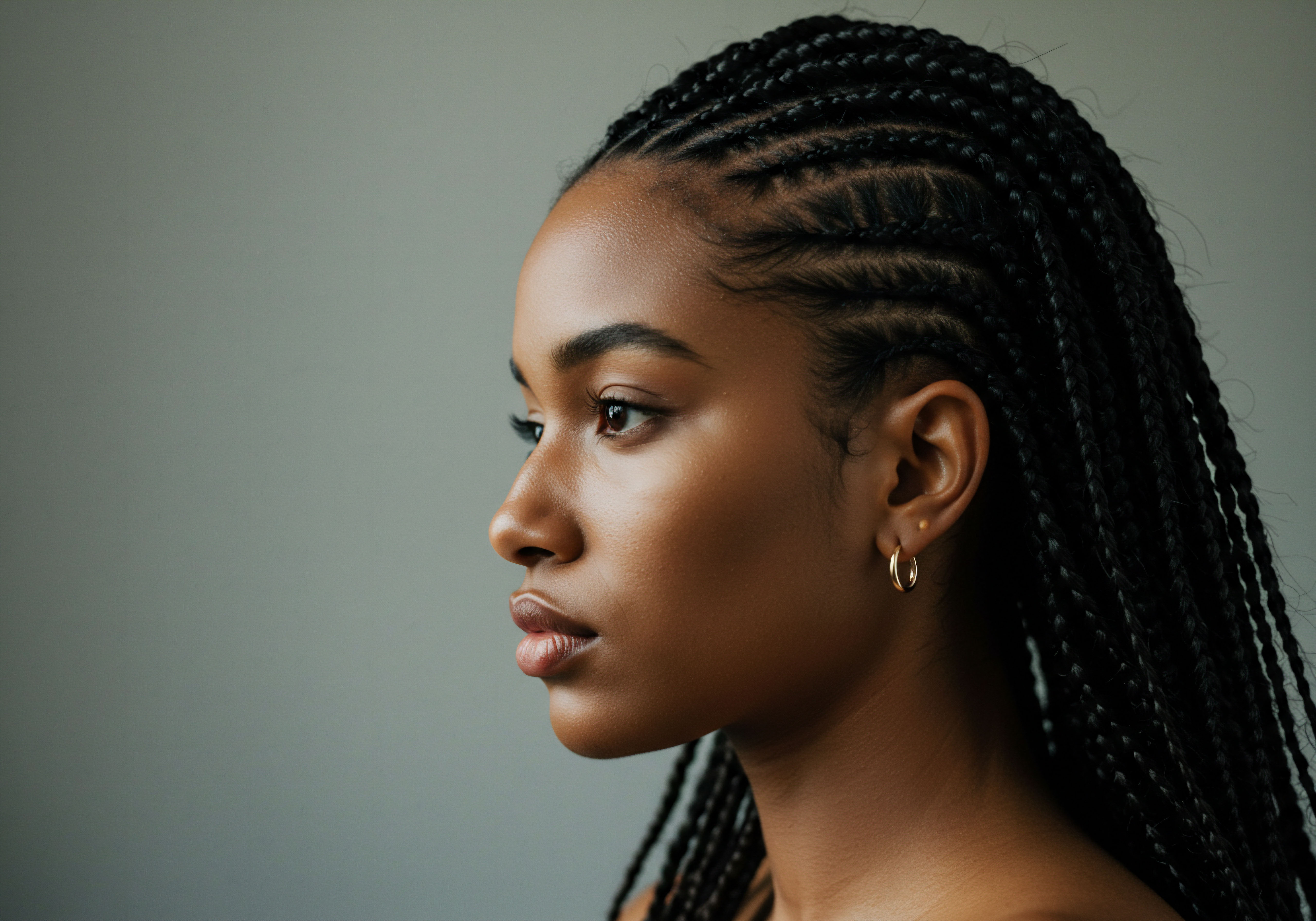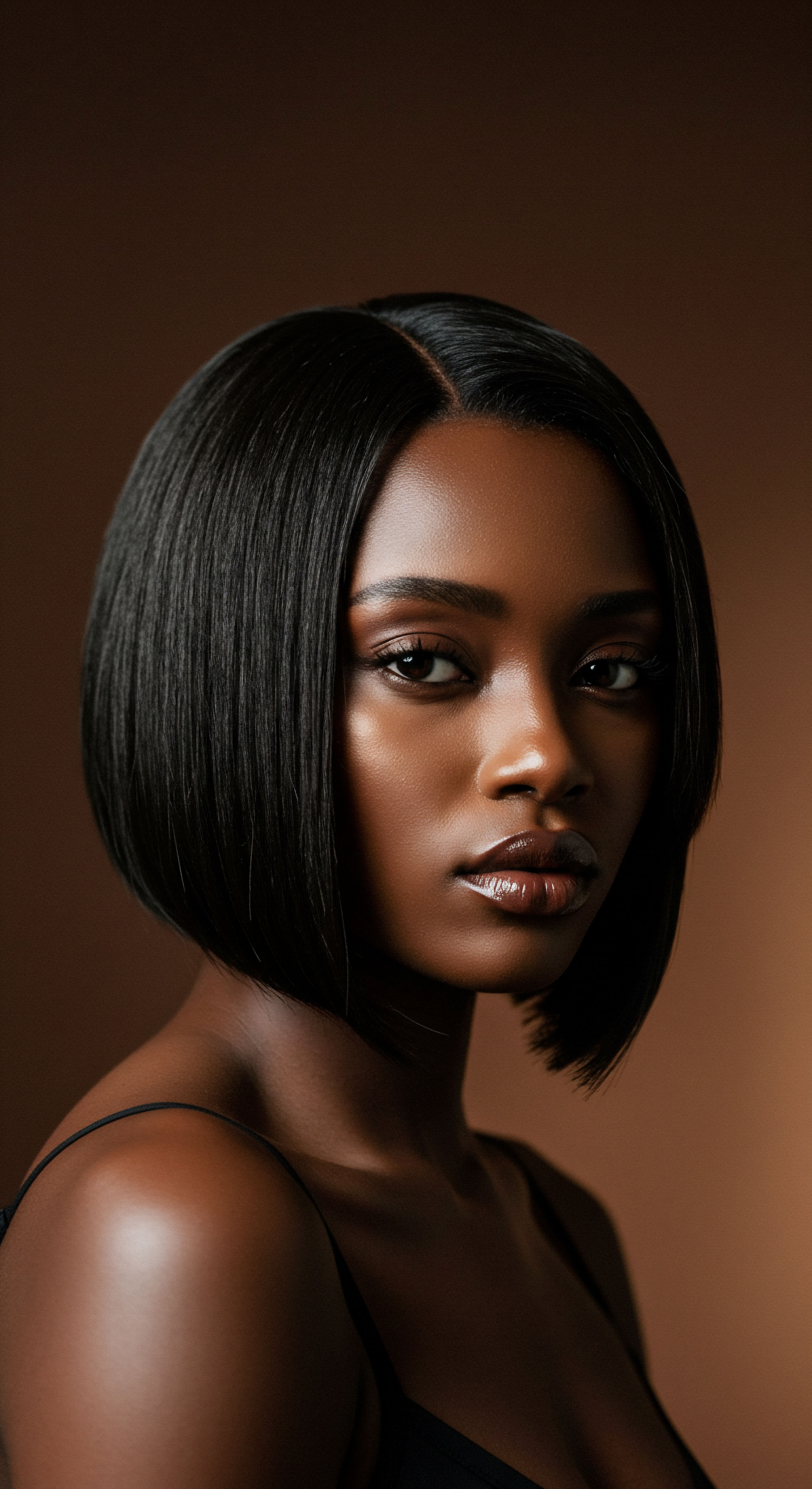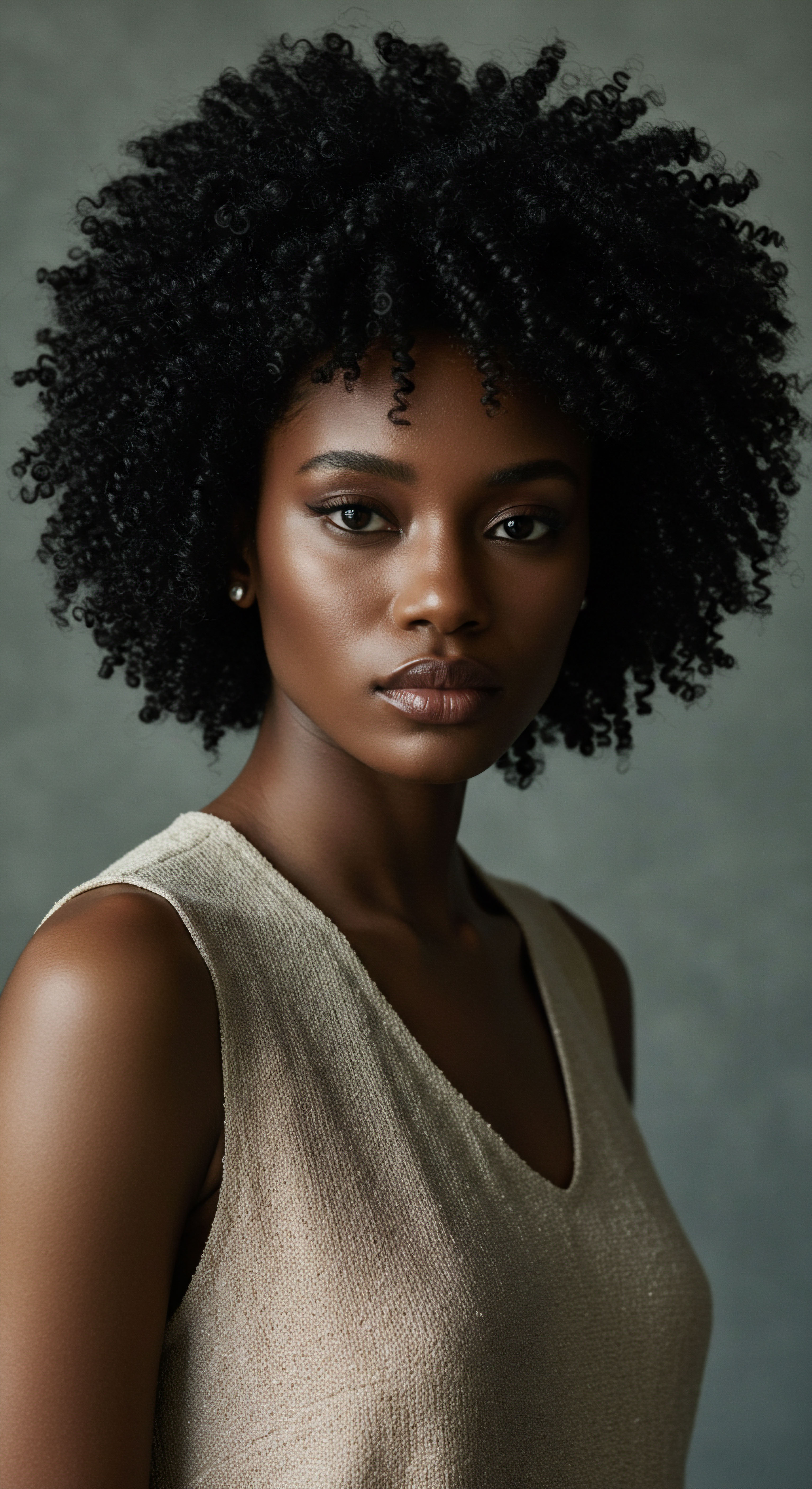
Roots
To truly grasp the profound interplay between the ancient Egyptian climate and the rituals surrounding hair care, one must first feel the sun-baked air, taste the desert dust, and hear the gentle murmur of the Nile. It is not merely a historical curiosity; it is a story etched into the very fibers of existence, a tale of human ingenuity and adaptation born from a landscape both nurturing and unforgiving. The environment was a sculptor, shaping not only the land but also the very strands adorning the heads of pharaohs, priests, and common folk alike. Understanding this elemental connection offers a unique window into their daily lives and their reverence for self-presentation.

A Sun Drenched Domain
The Egyptian landscape, primarily an arid desert, presented formidable challenges for maintaining healthy hair. Relentless solar radiation, fine particulate matter from the desert winds, and exceedingly low humidity conspired against the natural moisture balance of hair. The sun’s intense ultraviolet rays, day after day, could degrade the hair’s protein structure, specifically its Keratin.
This degradation could lead to a compromised cuticle, the outermost protective layer of the hair shaft, making strands brittle and prone to breakage. The desert winds, carrying abrasive sand and dust, would further strip away any residual moisture, lodging microscopic particles within the hair and on the scalp, potentially causing irritation and dryness.
The ancient Egyptian climate, characterized by intense sun, arid air, and pervasive dust, presented significant challenges for maintaining hair health.

Hair’s Ancient Architecture Under Siege
Consider the intrinsic nature of textured hair, often characterized by its unique curl patterns and a more open cuticle structure compared to straighter hair types. This inherent architecture, while beautiful, can render it more susceptible to moisture loss in dry environments. The natural oils produced by the scalp, known as Sebum, struggle to travel down the spiraling shaft of coiled hair, leaving the ends particularly vulnerable to dryness.
In the harsh Egyptian climate, this natural predisposition for dryness would have been greatly exacerbated, necessitating deliberate and consistent measures to counteract the environmental assault. The ancient Egyptians, through generations of observation and practice, developed an intimate understanding of these vulnerabilities.

The Silent Scars of the Sun and Wind
Beyond mere dryness, the constant exposure to intense sunlight and abrasive winds could lead to more serious conditions. The scalp, often exposed, faced the risk of sunburn and chronic irritation. Hair strands, stripped of their natural moisture and protective oils, could become dull, rough, and tangled.
The cumulative effect of these environmental stressors would have made hair management a significant daily concern, far removed from a mere aesthetic choice. It was a practical necessity, a way to preserve the vitality of their crowning glory in the face of nature’s relentless forces.

How Did Desert Winds Affect Hair Texture?
The pervasive desert winds, laden with fine sand and dust, acted as a constant abrasive force upon the hair shaft. This mechanical friction, combined with the extreme dryness, could physically lift the delicate Cuticle Scales, leading to a rougher hair surface. For individuals with textured hair, where cuticle scales may already be naturally more lifted, this effect would have been particularly pronounced.
The result was hair that felt coarse, appeared frizzy, and was prone to tangling and knotting. This environmental interaction likely drove the widespread adoption of protective styles and the liberal use of emollient substances to smooth the hair’s surface and shield it from the elements.
The scarcity of water, a precious commodity in the desert, also played a significant role. While the Nile provided a lifeline, its waters were not always readily accessible for daily, extensive hair washing. This necessitated the development of hair care practices that minimized water usage, prioritizing moisturizing and protective strategies over frequent cleansing. The ingenuity of their solutions speaks volumes about their deep connection to their bodies and their environment.

Ritual
Stepping from the foundational understanding of climate’s influence, we turn now to the deliberate actions, the practiced hands, and the gathered ingredients that formed the core of ancient Egyptian hair care. These were not random acts but carefully observed rituals, born from generations of wisdom, each gesture serving a purpose in the grand effort to protect and adorn the hair. Their approach offers a glimpse into a society that valued personal presentation as an extension of one’s identity and spiritual well-being.

The Oiling Traditions and Their Deep Roots
Central to ancient Egyptian hair care was the liberal application of oils and fats. These substances served as a crucial defense against the arid climate, acting as occlusives to seal moisture into the hair shaft and create a protective barrier against the sun and dust. Common oils included Castor Oil, Moringa Oil, and Almond Oil, often blended with aromatic resins or plant extracts for fragrance and additional benefits. Animal fats, such as ox fat, were also utilized, providing a heavier, more substantial coating.
These emollients were meticulously worked into the hair and scalp, nourishing the skin and softening the strands. The archaeological record, particularly from tombs, provides a wealth of evidence for these practices.
| Ingredient Castor Oil |
| Primary Purpose Moisturizer, conditioner |
| Climate-Related Benefit Forms a barrier against dryness, adds sheen. |
| Ingredient Moringa Oil |
| Primary Purpose Nourishing, protective |
| Climate-Related Benefit Rich in antioxidants, helps shield from sun damage. |
| Ingredient Almond Oil |
| Primary Purpose Softening, emollient |
| Climate-Related Benefit Lightweight moisture, aids detangling. |
| Ingredient Ox Fat |
| Primary Purpose Heavy conditioner, styling aid |
| Climate-Related Benefit Provides significant moisture retention, seals cuticles. |
| Ingredient Natron |
| Primary Purpose Cleansing agent |
| Climate-Related Benefit Gentle cleansing, absorbs impurities. |
| Ingredient Henna |
| Primary Purpose Colorant, conditioner |
| Climate-Related Benefit Strengthens hair, offers sun protection. |
| Ingredient These ingredients formed the foundation of ancient Egyptian hair wellness practices. |

Cleansing Rites in a Water Scarce Land
While oils were paramount, cleansing was also a component of their regimen, albeit likely less frequent than modern practices. The ancient Egyptians did not have access to manufactured soaps as we know them today. Instead, they relied on natural cleansing agents. Natron, a naturally occurring mineral salt, was used as a mild detergent, capable of absorbing oils and impurities from the hair and scalp.
Plant-based saponins, found in plants like soapwort or acacia, also provided gentle lathering and cleansing properties. These methods aimed to refresh the hair without stripping it of its essential oils, a vital consideration in a dry environment where moisture preservation was key.
Ancient Egyptian hair care centered on moisturizing oils and protective styles, with cleansing rituals adapted to water scarcity.

Protective Artistry and Adornment
Perhaps the most visually striking aspect of ancient Egyptian hair care was their mastery of protective styling and the widespread use of wigs. Braids, particularly tight, intricate braids, were a practical solution. They minimized exposure to the elements, reduced tangling, and locked in moisture from applied oils. For those who could afford them, wigs were not merely fashion statements; they served as a comprehensive protective shield.
Crafted from human hair, plant fibers, or even wool, these wigs were often heavily oiled and styled, providing an additional layer of defense against the sun’s harsh rays and the pervasive dust. Shaving the head and wearing a wig also offered a hygienic solution, reducing issues with lice and scalp irritation in the hot climate.
- Braids ❉ Reduced tangling, protected hair from environmental damage, and retained moisture.
- Wigs ❉ Offered superior sun protection, hygienic benefits, and allowed for elaborate styling without damaging natural hair.
- Head Coverings ❉ Provided an additional layer of defense against dust and solar radiation.

Tools of the Trade and Daily Devotion
The tools used in ancient Egyptian hair care, though simple by modern standards, were effective and meticulously crafted. Combs made from wood, bone, or ivory were common, used for detangling and styling. Hairpins, often decorative, secured elaborate coiffures.
For those who chose to shave their heads, copper or bronze razors were employed with considerable skill. These tools, alongside the precious oils and the art of wig-making, illustrate a society deeply invested in the daily devotion to their hair, understanding its fragility and its power as a symbol.

Relay
Beyond the daily rituals and immediate environmental responses, a deeper inquiry reveals how ancient Egyptian hair care was woven into the very fabric of their society, reflecting status, belief, and an astonishing grasp of material science. This exploration transcends mere practice, inviting us to consider the intricate interplay of cultural norms, personal expression, and the enduring quest for well-being in a challenging world. The answers lie not just in what they did, but why it held such profound significance.

What Did Hair Reveal About Social Standing?
Hair, or its elaborate replacement in the form of wigs, served as a potent visual cue for social standing in ancient Egypt. While common laborers might wear their natural hair simply or shaved for hygiene, the elite adorned themselves with elaborate, often voluminous wigs. The quality of the wig, the intricacy of its styling, and the richness of the oils used to maintain it were direct indicators of wealth and status.
Royal and noble individuals could afford the finest human hair wigs, meticulously braided and perfumed. These elaborate constructions, while offering unparalleled protection from the sun and dust, also proclaimed their wearer’s position at the pinnacle of society, where resources for such meticulous self-care were abundant.

Unearthing Ancient Hair’s Chemical Secrets
Modern scientific analysis of mummified hair samples has provided extraordinary insights into ancient Egyptian hair care practices and the very composition of their hair. A study published in the Journal of Archaeological Science by Joann Fletcher and colleagues (2007) analyzed hair samples from various mummies, revealing not only the presence of specific cosmetic residues but also surprising details about hair health. For instance, the analysis often detected high levels of iron, suggesting the use of iron-rich pigments or even a diet contributing to mineral deposition in hair.
More compellingly, some samples exhibited a significant preservation of the hair’s internal structure, indicative of consistent application of conditioning agents that mitigated the harsh environmental effects. This research provides a tangible, chemical footprint of their success in hair preservation.
Scientific analysis of ancient Egyptian hair samples confirms the efficacy of their hair care practices in preserving hair structure against environmental stressors.
This research offers a unique perspective ❉ it demonstrates that the ancient Egyptians were not simply applying substances randomly. Their methods, honed over centuries, had measurable biochemical effects on the hair, protecting its integrity against the extreme climate. The findings from these studies challenge any simplistic notion of ancient beauty rituals as purely superficial. Instead, they underscore a sophisticated understanding of material properties and their application for health and aesthetic purposes.

The Symbolic Strands and Spiritual Significance
Hair held deep symbolic meaning beyond social status. It played a role in religious ceremonies, mourning rites, and even magic. Priests often shaved their heads to signify purity and devotion. During periods of mourning, women might leave their hair unkempt or cut it short as a visible sign of grief.
Conversely, elaborate hairstyles and wigs could be associated with festivals and celebrations, embodying vitality and joy. The meticulous care of hair, even in death, as evidenced by the preserved hairstyles on mummies, points to a belief in the enduring importance of personal presentation in the afterlife.
- Mourning Rituals ❉ Hair might be disheveled or cut short to express profound grief.
- Religious Purity ❉ Priests often shaved their heads to signify their sacred role and cleanliness.
- Funerary Practices ❉ Elaborate wigs and hairstyles were preserved on mummies, suggesting their continued importance in the afterlife.

Lessons Across Millennia for Textured Hair
The ancient Egyptian approach to hair care, particularly their reliance on protective styles and heavy oils, offers profound parallels and lessons for modern textured hair care. In climates where humidity is low or environmental aggressors are high, the principles remain strikingly relevant. The concept of sealing in moisture, protecting delicate strands from physical damage, and creating a barrier against the elements are foundational to maintaining healthy coils and curls today. Their wisdom, born from necessity, continues to resonate, providing a timeless blueprint for hair resilience.
The longevity of their practices, spanning thousands of years, speaks to their effectiveness. The ancient Egyptians understood, through empirical observation, that hair health was intrinsically linked to its environment and that proactive measures were required to maintain its vitality. This deep understanding, supported by the chemical evidence from archaeological discoveries, positions them as early pioneers in what we might today call holistic hair wellness, demonstrating a profound connection between personal care and the natural world.

Reflection
The echoes of ancient Egypt’s climate-driven hair care rituals continue to whisper across the millennia, reminding us that the quest for hair wellness is a timeless endeavor, deeply connected to our surroundings. Their meticulous practices, born from the crucible of desert sun and sand, speak to a universal truth ❉ understanding and adapting to our environment is key to nurturing our strands. We are left with a quiet appreciation for their ingenuity, a testament to human resilience and the enduring desire to care for what grows from us, linking past wisdom with present practices in a continuous, flowing story.

References
- Fletcher, Joann, et al. “Mummified hair ❉ The chemical analysis of ancient Egyptian hair.” Journal of Archaeological Science, vol. 34, no. 8, 2007, pp. 1292-1301.
- Germer, Renate. Ancient Egyptian Mummies ❉ A Very Short Introduction. Oxford University Press, 2017.
- Lucas, Alfred. Ancient Egyptian Materials and Industries. 4th ed. Edward Arnold, 1962.
- Manniche, Lise. An Ancient Egyptian Herbal. British Museum Press, 1989.
- Robins, Gay. Women in Ancient Egypt. Harvard University Press, 1993.
- Shafer, Byron E. Temples of Ancient Egypt. Cornell University Press, 2005.
- Tyldesley, Joyce. Daughters of Isis ❉ Women of Ancient Egypt. Penguin Books, 1994.